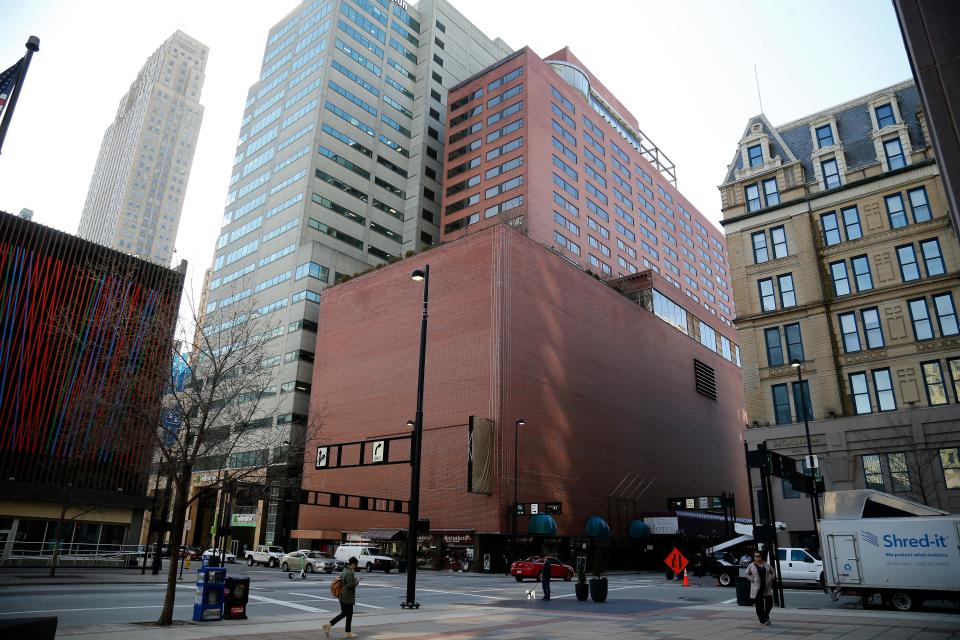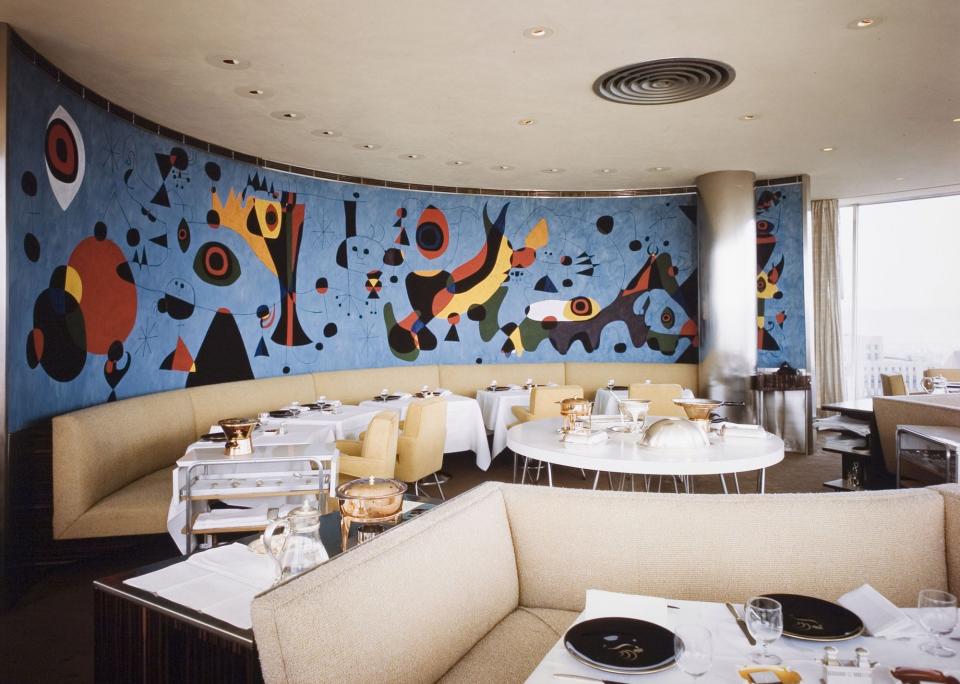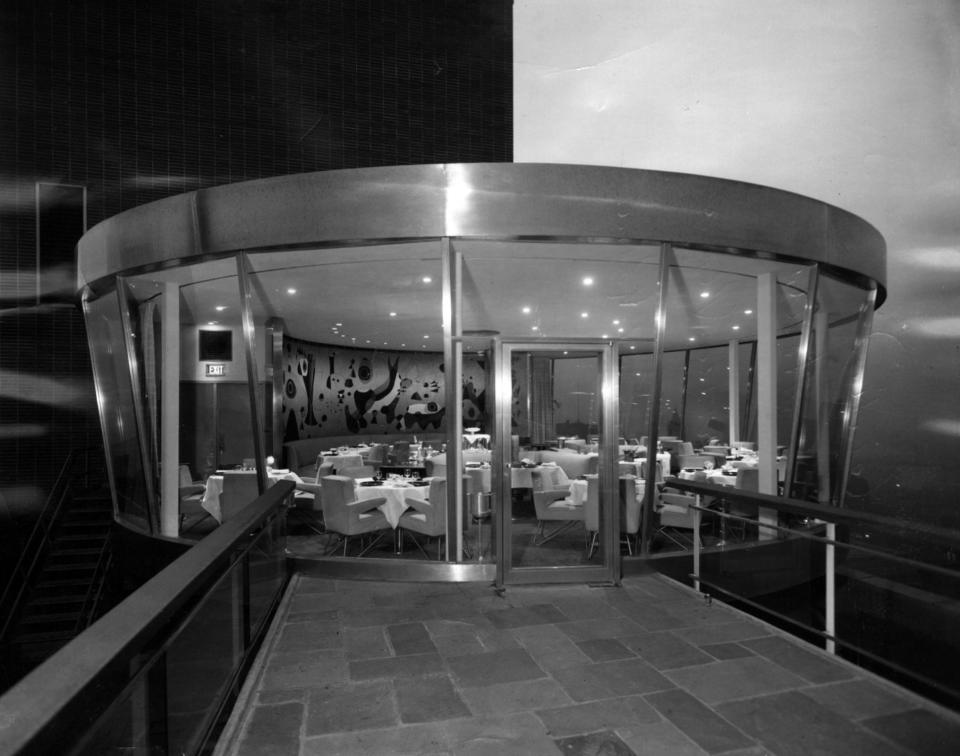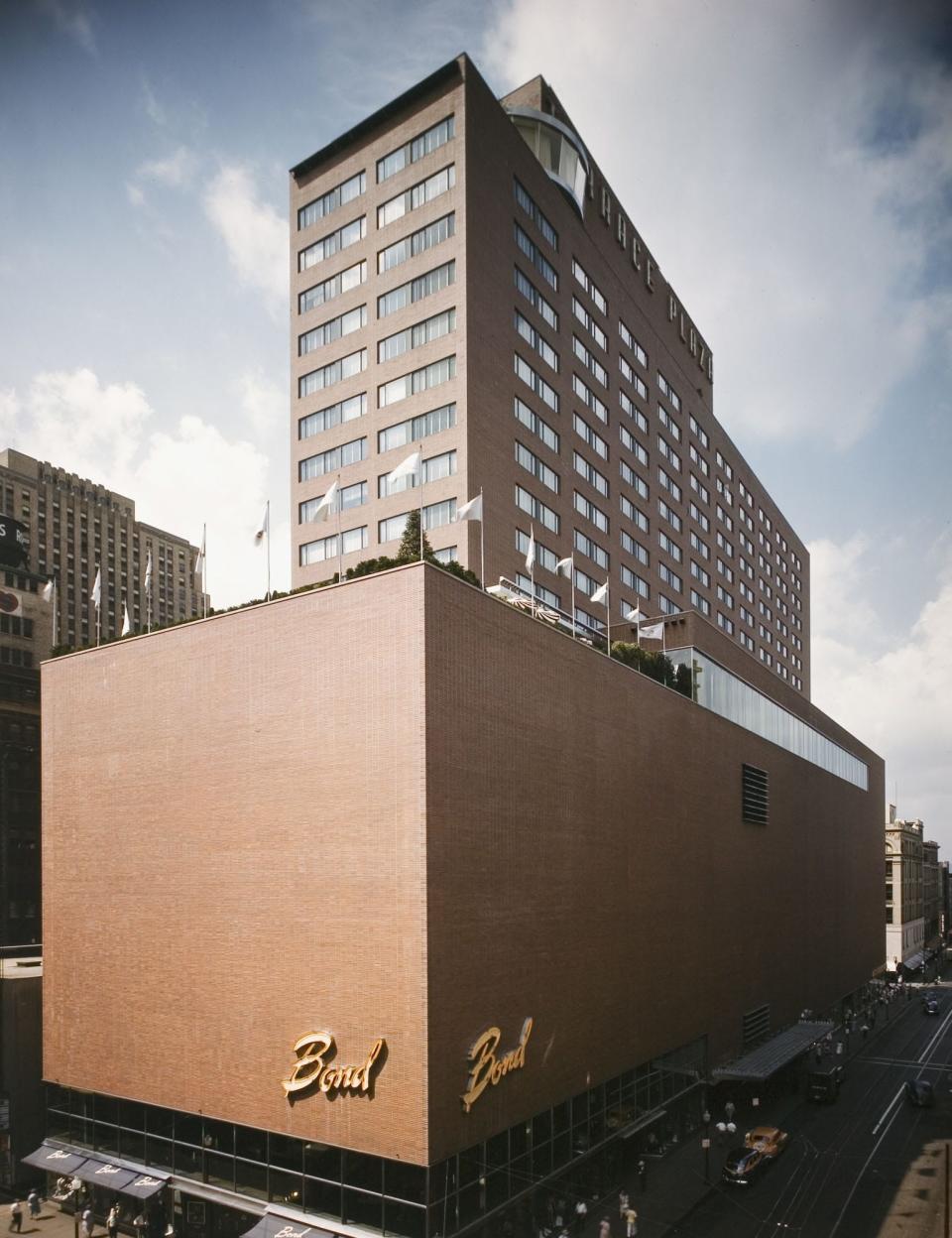75 years ago, Terrace Plaza Hotel was the talk of the town. Now it's a forgotten icon
This is part of The Enquirer's series on the Future of Downtown.
For the past few decades, you might be excused if you didn’t know that the red brick monolith at 15 W. Sixth St., covering the block between Vine and Race streets, was one of Cincinnati’s most celebrated buildings.
From a distance you can tell it’s actually a stack of brick blocks. From the street level, you can see only a few stores, including the famous Batsakes Hat Shop, then a six-story wall of brick without windows. On top of that, an empty hotel. Doesn’t seem very historic.
That’s because it has been neglected for years. The Terrace Plaza Hotel was once the talk of the whole country.

Downtown Cincinnati: What the past tells us
It was 75 years ago this week, on July 19, 1948, that the national spotlight shone on the grand opening of what was heralded as the first major hotel built after World War II, one that incorporated the trends of the new modernism stylistic movement.
The media went to see the Terrace Plaza Hotel for a preview a few days earlier on July 16. Life magazine, Time, Architectural Forum and Harper’s Bazaar did write-ups on the hotel. One guest raved, “It’s out of this world by a large margin.”
Harper’s Magazine wrote, “If you want to discover what your grandchildren will think of as elegance of this postwar era, you will have to go to Cincinnati, and take an elevator up to the eighth floor of a pink brick building.”
Design embraced modernism
The $12 million project was developed by John J. “Jack” Emery Jr., whose family business traced back to Thomas Emery’s lard oil factory during Cincinnati’s Porkopolis days. Emery had also built Cincinnati’s Carew Tower, which in 1930 had been one of the earliest mixed-use buildings, with offices, retail and a hotel – the Netherland Plaza.
With the Terrace Plaza, Emery aimed to make something more modern. For one thing, the lobby terrace was all the way up on the eighth floor, accessed by express elevators from a sleekly modern street entrance. That was certainly a novel idea.
The lower block of the utilitarian brick structure housed department stores – originally J.C. Penney and a Bond clothing store. The sidewalk display windows were the only break in the brick curtain on the lower floors.
The hotel itself was in the building’s upper block. An open-air plaza with seating for the Terrace Garden restaurant led to the lobby. The hotel was modern to the standards of the day. Each room had its own air conditioning and thermostat, plus a radio and a telephone. Beds slid out of the walls at the flip of a switch.
Emery, who was also the president of the Cincinnati Art Museum, commissioned Spanish artist Joan Miró to create a mural to adorn the curved wall of the Gourmet Room restaurant. Another mural by cartoonist Saul Steinberg was in the Skyline dining room. “Twenty Leaves of an Apple,” a mobile by Alexander Calder, hung from the lobby ceiling. Dynamic sculptures by Jim Davis were installed in the Terrace Garden bar.

The Gourmet Room, a circular restaurant with glass walls that cantilevered over the edges of the 20th floor, was the one variation in the straight lines of the hotel’s design. It appeared like a flying saucer perched on the roof with spectacular views of the city. A city that looked quaint and old in comparison.
“There is the feeling of straddling the ages in standing on the observation platform atop the modern Terrace Plaza, outside the glass body of the ultramodern Gourmet Restaurant,” Enquirer city editor John F. Cronin wrote 75 years ago.
After calling the Terrace Plaza “the most modern building in existence,” he noted: “It is new and resplendent, a delightful contrast to the setting among other buildings that have outlived their appeal … ”

But modernism didn’t seem modern for long.
Emery sold the hotel to the Hilton chain in 1956. In 1965, he negotiated the art pieces to go to the Cincinnati Art Museum, although the Davis sculpture and 14 feet of the Steinberg mural had gone missing and were never recovered. The remaining pieces are still on display at the museum.
Over the next several decades, the hotel went through many names – the Terrace Hilton, the Crowne Plaza and finally the Terrace Hotel – then closed abruptly Oct. 31, 2008.
The historic importance of the building was mostly forgotten by then.
About that time, Shawn Patrick Tubb, an architecture student at the University of Cincinnati’s College of Design, Architecture, Art and Planning, was working on his master’s thesis on how to develop the Terrace Plaza for reuse, and he began digging into the building’s history.
Early design by SOM and architectural pioneer Natalie de Blois
The Terrace Plaza Hotel was also notable for who designed it. It was the first major project of Chicago-based architects Skidmore, Owings & Merrill, or SOM. The firm went on to design some of the tallest buildings in the world, including the Willis Tower (formerly Sears Tower) in Chicago and the Burj Khalifa in Dubai, currently the world’s tallest.
Left largely unrecognized until Tubb’s research was the senior designer on the project, 24-year-old Natalie de Blois.
“While she was one of SOM’s star designers, she was almost never credited and often treated differently because of being a woman,” Tubb wrote in his book, “Cincinnati’s Terrace Plaza Hotel: An Icon of American Modernism.”

She worked on the designs of the Pepsi-Cola headquarters, the Union Carbide Building and the Lever House, all in New York City, and the Equitable Building in Chicago. Her first major project was Terrace Plaza.
De Blois did the space planning and designed the structure and the interiors of the Terrace Plaza from SOM’s New York office, Tubb reported.
“I never saw the site,” de Blois told Tubb. “They never took me to Cincinnati, and I never met the client.”
“This was not considered unusual at the time because of her gender,” Tubb wrote. Many of the meetings with the client were held in a men’s club, where she was not allowed.
Tubb invited de Blois, who lived in Chicago, to visit Cincinnati in November 2008 to see the building she helped create and to be honored by the Cincinnati Preservation Association for her contribution to the city’s architectural history.
Although the hotel closed weeks before her visit, Tubb and de Blois were granted permission to tour the building – and she saw the milestone building she designed for the first time. She died in 2013.
New life for the old icon
After decades of failed plans to renovate and reuse the Terrace Plaza Hotel building, it looks as though it is finally getting the renovation that such a once-celebrated building deserves.
Indianapolis-based developer Birkla Investment Group, which purchased the building in September 2022, has teamed with Reztark Design Studio of Cincinnati to reimagine the midcentury modernist building in a contemporary style, according to previous Enquirer reporting. The building will get a facelift and a new name: The Terraces.
New life for a classic, but mostly ignored icon. Maybe by its 80th birthday, the Terrace Plaza will have a new story.
This article originally appeared on Cincinnati Enquirer: Cincinnati's Terrace Plaza Hotel went from celebrated to forgotten

